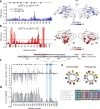Structural elements in the flexible tail of the co-chaperone p23 coordinate client binding and progression of the Hsp90 chaperone cycle
- PMID: 33547294
- PMCID: PMC7864943
- DOI: 10.1038/s41467-021-21063-0
Structural elements in the flexible tail of the co-chaperone p23 coordinate client binding and progression of the Hsp90 chaperone cycle
Abstract
The co-chaperone p23 is a central part of the Hsp90 machinery. It stabilizes the closed conformation of Hsp90, inhibits its ATPase and is important for client maturation. Yet, how this is achieved has remained enigmatic. Here, we show that a tryptophan residue in the proximal region of the tail decelerates the ATPase by allosterically switching the conformation of the catalytic loop in Hsp90. We further show by NMR spectroscopy that the tail interacts with the Hsp90 client binding site via a conserved helix. This helical motif in the p23 tail also binds to the client protein glucocorticoid receptor (GR) in the free and Hsp90-bound form. In vivo experiments confirm the physiological importance of ATPase modulation and the role of the evolutionary conserved helical motif for GR activation in the cellular context.
Conflict of interest statement
The authors declare no competing interests.
Figures







Similar articles
-
The conserved NxNNWHW motif in Aha-type co-chaperones modulates the kinetics of Hsp90 ATPase stimulation.Nat Commun. 2019 Mar 20;10(1):1273. doi: 10.1038/s41467-019-09299-3. Nat Commun. 2019. PMID: 30894538 Free PMC article.
-
A switch point in the molecular chaperone Hsp90 responding to client interaction.Nat Commun. 2018 Apr 16;9(1):1472. doi: 10.1038/s41467-018-03946-x. Nat Commun. 2018. PMID: 29662162 Free PMC article.
-
Modulation of the Hsp90 chaperone cycle by a stringent client protein.Mol Cell. 2014 Mar 20;53(6):941-53. doi: 10.1016/j.molcel.2014.02.003. Epub 2014 Mar 6. Mol Cell. 2014. PMID: 24613341
-
p23 and Aha1: Distinct Functions Promote Client Maturation.Subcell Biochem. 2023;101:159-187. doi: 10.1007/978-3-031-14740-1_6. Subcell Biochem. 2023. PMID: 36520307 Review.
-
p23 and Aha1.Subcell Biochem. 2015;78:113-31. doi: 10.1007/978-3-319-11731-7_6. Subcell Biochem. 2015. PMID: 25487019 Review.
Cited by
-
Visualizing the transiently populated closed-state of human HSP90 ATP binding domain.Nat Commun. 2022 Dec 9;13(1):7601. doi: 10.1038/s41467-022-35399-8. Nat Commun. 2022. PMID: 36494347 Free PMC article.
-
Molecular mechanisms of chaperone-directed protein folding: Insights from atomistic simulations.Protein Sci. 2023 Dec 25;33(3):e4880. doi: 10.1002/pro.4880. Online ahead of print. Protein Sci. 2023. PMID: 38145386 Free PMC article.
-
Client binding shifts the populations of dynamic Hsp90 conformations through an allosteric network.Sci Adv. 2021 Dec 17;7(51):eabl7295. doi: 10.1126/sciadv.abl7295. Epub 2021 Dec 17. Sci Adv. 2021. PMID: 34919431 Free PMC article.
-
Heat shock proteins: Biological functions, pathological roles, and therapeutic opportunities.MedComm (2020). 2022 Aug 2;3(3):e161. doi: 10.1002/mco2.161. eCollection 2022 Sep. MedComm (2020). 2022. PMID: 35928554 Free PMC article. Review.
-
Heat Shock Proteins in Benign Prostatic Hyperplasia and Prostate Cancer.Int J Mol Sci. 2022 Jan 14;23(2):897. doi: 10.3390/ijms23020897. Int J Mol Sci. 2022. PMID: 35055079 Free PMC article. Review.
References
Publication types
MeSH terms
Substances
LinkOut - more resources
Full Text Sources
Other Literature Sources
Molecular Biology Databases

